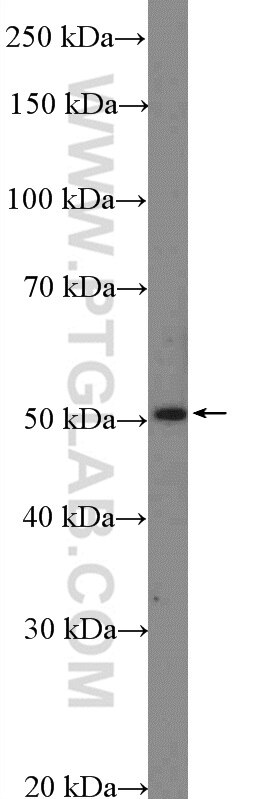Tested Applications
| Positive WB detected in | HeLa cells |
Recommended dilution
| Application | Dilution |
|---|---|
| Western Blot (WB) | WB : 1:500-1:1000 |
| It is recommended that this reagent should be titrated in each testing system to obtain optimal results. | |
| Sample-dependent, Check data in validation data gallery. | |
Product Information
18835-1-AP targets TFAP2D in WB, ELISA applications and shows reactivity with human, mouse, rat samples.
| Tested Reactivity | human, mouse, rat |
| Host / Isotype | Rabbit / IgG |
| Class | Polyclonal |
| Type | Antibody |
| Immunogen |
Peptide Predict reactive species |
| Full Name | transcription factor AP-2 delta (activating enhancer binding protein 2 delta) |
| Calculated Molecular Weight | 50 kDa |
| Observed Molecular Weight | 47-52 kDa |
| GenBank Accession Number | BC166653 |
| Gene Symbol | TFAP2D |
| Gene ID (NCBI) | 83741 |
| RRID | AB_2878562 |
| Conjugate | Unconjugated |
| Form | Liquid |
| Purification Method | Antigen affinity purification |
| UNIPROT ID | Q7Z6R9 |
| Storage Buffer | PBS with 0.02% sodium azide and 50% glycerol, pH 7.3. |
| Storage Conditions | Store at -20°C. Stable for one year after shipment. Aliquoting is unnecessary for -20oC storage. 20ul sizes contain 0.1% BSA. |
Background Information
TFAP2D, also named as TFAP2BL1, belongs to the AP-2 family. TFAP2D is a sequence-specific DNA-binding protein that interacts with inducible viral and cellular enhancer elements to regulate transcription of selected genes. AP-2 factors bind to the consensus sequence 5'-GCCNNNGGC-3' and activate genes involved in a large spectrum of important biological functions including proper eye, face, body wall, limb and neural tube development. They also suppress a number of genes including MCAM/MUC18, C/EBP alpha and MYC. It is highly expressed in adult thymus, prostate, small intestine, skeletal muscle, placenta, brain, and testis tissues.
Protocols
| Product Specific Protocols | |
|---|---|
| WB protocol for TFAP2D antibody 18835-1-AP | Download protocol |
| Standard Protocols | |
|---|---|
| Click here to view our Standard Protocols |




